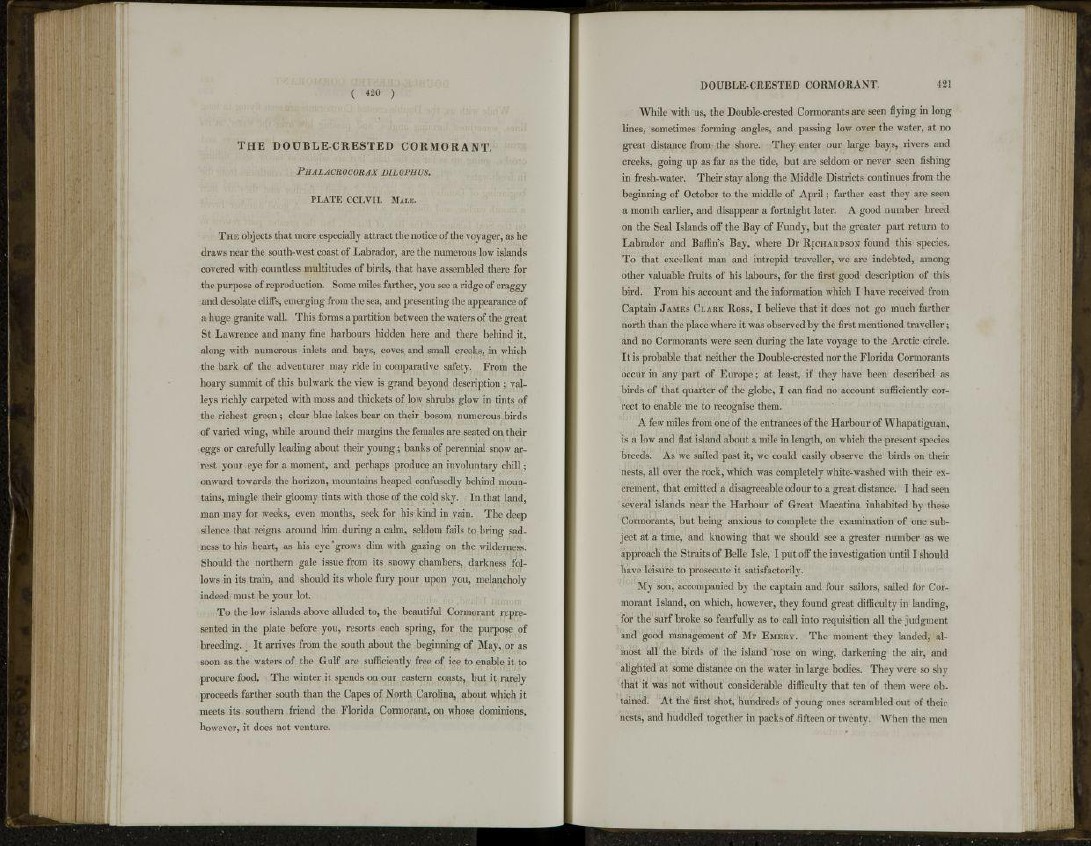
THE DOUBLE-CRESTED CORMORANT.
P H A L A C R O C O R A X D I L O P H U S.
PLATE CCLVII. MALE.
T H E objects that more especially attract the notice of the voyager, as he
draws near the south-west coast of Labrador, are the numerous low islands
covered with countless multitudes of birds, that have assembled there for
the purpose of reproduction. Some miles farther, you see a ridge of craggy
and desolate cliffs, emerging from the sea, and presenting the appearance of
a huge granite wall. This forms a partition between the waters of the great
St Lawrence and many fine harbours hidden here and there behind it,
along with numerous inlets and bays, coves and small creeks, in which
the bark of the adventurer may ride in comparative safety. From the
hoary summit of this bulwark the view is grand beyond description ; valleys
richly carpeted with moss and thickets of low shrubs glow in tints of
the richest green ; clear blue lakes bear on their bosom numerous birds
of varied wing, while around their margins the females are seated on their
eggs or carefully leading about their young; banks of perennial snow arrest
your eye for a moment, and perhaps produce an involuntary chill;
onward towards the horizon, mountains heaped confusedly behind mountains,
mingle their gloomy tints with those of the cold sky. In that land,
man may for weeks, even months, seek for his kind in vain. The deep
silence that reigns around him during a calm, seldom fails to bring sadness
to his heart, as his eye'grows dim with gazing on the wilderness.
Should the northern gale issue from its snowy chambers, darkness follows
in its train, and should its whole fury pour upon you, melancholy
indeed must be your lot.
To the low islands above alluded to, the beautiful Cormorant represented
in the plate before you, resorts each spring, for the purpose of
breeding. It arrives from the south about the beginning of May, or as
soon as the waters of the Gulf are sufficiently free of ice to enable it to
procure food. The winter it spends on our eastern coasts, but it rarely
proceeds farther south than the Capes of North Carolina, about which it
meets its southern friend the Florida Cormorant, on whose dominions,
however, it does not venture.
DOUBLE-CRESTED CORMORANT. 421
While with us, the Double-crested Cormorants are seen flying in long
lines, sometimes forming angles, and passing low over the water, at no
great distance from the shore. They enter our large bays, rivers and
creeks, going up as far as the tide, but are seldom or never seen fishing
in fresh-water. Their stay along the Middle Districts continues from the
beginning of October to the middle of April; farther east they are seen
a month earlier, and disappear a fortnight later. A good number breed
on the Seal Islands off the Bay of Fundy, but the greater part return to
Labrador and Baffin's Bay, where Dr RICHARDSON found this species..
To that excellent man and intrepid traveller, we are indebted, among
other valuable fruits of his labours, for the first good description of this
bird. From his account and the information which I have received from
Captain JAMES CLARK Ross, I believe that it does not go much farther
north than the place where it was observed by the first mentioned traveller;
and no Cormorants were seen during the late voyage to the Arctic circle.
It is probable that neither the Double-crested nor the Florida Cormorants
occur in any part of Europe; at least, if they have been described as
birds of that quarter of the globe, I can find no account sufficiently correct
to enable me to recognise them.
A few miles from one of the entrances of the Harbour of Whapatiguan,
is a low and flat island about a mile in length, on which the present species
breeds. As we sailed past it, we could easily observe the birds on their
nests, all over the rock, which was completely white-washed with their excrement,
that emitted a disagreeable odour to a great distance. I had seen
several islands near the Harbour of Great Macatina inhabited by these
Cormorants, but being anxious to complete the examination of one subject
at a time, and knowing that we should see a greater number as we
approach the Straits of Belle Isle, I put off the investigation until I should
have leisure to prosecute it satisfactorily.
My son, accompanied by the captain and four sailors, sailed for Cormorant
Island, on which, however, they found great difficulty in landing,
for the surf broke so fearfully as to call into requisition all the judgment
and good management of Mr EMERY. The moment they landed, almost
all the birds of the island rose on wing, darkening the air, and
alighted at some distance on the water in large bodies. They were so shy
that it was not without considerable difficulty that ten of them were obtained.
At the first shot, hundreds of young ones scrambled out of their
nests, and huddled together in packs of -fifteen or twenty. When the men